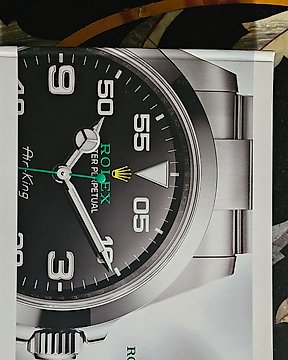Item as described. Smooth transaction. Reliable seller.
Se oversættelse[Porcelain] / Oliver Impey and Malcolm Fairley, e.a. - The Nasser D.Khalili Collection of Japanese Art, Meiji No Takara, Treasures of Imperial Japan - 1995
Nr. 87631241
![[Porcelain] / Oliver Impey and Malcolm Fairley, e.a. - The Nasser D.Khalili Collection of Japanese Art, Meiji No Takara, Treasures of Imperial Japan - 1995 #1.1](https://assets.catawiki.com/image/cw_ldp_l/plain/assets/catawiki/assets/2024/5/20/1/d/e/1de7ce62-d854-4aec-8295-963a57979e52.jpg)
![[Porcelain] / Oliver Impey and Malcolm Fairley, e.a. - The Nasser D.Khalili Collection of Japanese Art, Meiji No Takara, Treasures of Imperial Japan - 1995 #1.2](https://assets.catawiki.com/image/cw_ldp_l/plain/assets/catawiki/assets/2024/5/20/a/f/0/af02d763-e72f-42b5-be1f-e4ea2f3f3be7.jpg)
![[Porcelain] / Oliver Impey and Malcolm Fairley, e.a. - The Nasser D.Khalili Collection of Japanese Art, Meiji No Takara, Treasures of Imperial Japan - 1995 #2.1](https://assets.catawiki.com/image/cw_ldp_l/plain/assets/catawiki/assets/2024/5/20/7/e/5/7e5c1177-fb63-40e5-98cf-6ba15f040872.jpg)
The Nasser D.Khalili Collection of Japanese Art, Meiji No Takara, Treasures of Imperial Japan, Ceramics Part I Porcelain,Volume V,248 pages and Ceramics Part II Earthenware,Volume V, The Kibo Foundation,1995
The Khalili Collection of Japanese Art is a private collection of decorative art from Meiji-era (1868–1912) Japan, assembled by the British-Iranian scholar, collector and philanthropist Nasser D. Khalili. Its 1,400 art works include metalwork, enamels, ceramics, lacquered objects, and textile art, making it comparable only to the collection of the Japanese imperial family in terms of size and quality. The Meiji era was a time when Japan absorbed some Western cultural influences and used international events to promote its art, which became very influential in Europe. Rather than covering the whole range of Meiji-era decorative art, Khalili has focused on objects of the highest technical and artistic quality. Some of the works were made by artists of the imperial court for the Great Exhibitions of the late 19th century. The collection is one of eight assembled, published, and exhibited by Khalili.
Although the collection is not on permanent public display, its objects are lent to cultural institutions and have appeared in many exhibitions from 1994 onwards. Exhibitions drawing exclusively from the collection have been held at the British Museum, Israel Museum, Van Gogh Museum, Portland Museum, Moscow Kremlin Museums, and other institutions worldwide.
The collection is one of eight assembled by Nasser D. Khalili, each of which is considered among the most important in its field. Three of them include works from Japan: the collection of Japanese art, the Khalili Collection of Kimono, and the Khalili Collection of Enamels of the World. Khalili observed that Japanese arts were less well-documented than European arts of the same period, despite being technically superior: "Whilst one could argue it is relatively easy to replicate a Fabergé, to replicate the work of the Japanese master is nigh on impossible." As well as assembling these collections, Khalili founded the Kibo Foundation (from the Japanese word for "hope") to promote the study of art and design of the Meiji era, publishing scholarship about the collection and its historical context.
Porcelain
Oliver Impey and Malcolm Fairley with contributions by Clare Pollard and Vibeke Woldbye,
248 pages; fully illustrated in colour; 40 x 30 cm; hardback with slipcase; 1995; ISBN: 978-1-874780-05-2
The collection includes, among other porcelain works, more than eighty by Miyagawa (Makuzu) Kozan, described in 1910 as Japan's greatest living ceramic artist. Kozan was the second ceramicist ever to be appointed Artist to the Imperial Household. He and his workshop transformed underglaze blue porcelain, decorating with subtleties of colour that had not previously been possible. He also made award-winning objects with flambé or crystalline glaze. Some of his works showed the influence of European graphic design, while he combined traditional Japanese and Chinese techniques with new technologies from the West. The collection illustrates how he and his son Hanzan became increasingly ambitious, introducing new colours, designs and sculptural effects in works sent to international exhibitions.
Earthenware
Tsuyoshi, Tamazaki; Impey, Oliver; Fairley, Malcolm; Fairley, Malcol
300 pages; fully illustrated in colour; 40 x 30 cm; hardback with slipcase; 1995; ISBN: 978-1-874780-06-9
The 171 earthenware objects in the collection include some by Yabu Meizan and his contemporaries, typically decorated with enamel and gold.Meizan was not only a prolific producer but won multiple awards at national and international exhibitions, where his creations were exhibited as works of art. The collection shows that Meizan used Chinese as well as Japanese motifs in his decoration, drawing from sources including Buddhist imagery and the prints of Hiroshige.His designs became more intricate, sometimes using a thousand motifs in a single art work; towards the end of his career, however, he took a different approach, covering whole vases in a single motif.Kinkozan Sobei VII and Takbe Shoko are other distinctive decorators represented in the collection.
The Nasser D.Khalili Collection of Japanese Art, Meiji No Takara, Treasures of Imperial Japan, Ceramics Part I Porcelain,Volume V,248 pages and Ceramics Part II Earthenware,Volume V, The Kibo Foundation,1995
The Khalili Collection of Japanese Art is a private collection of decorative art from Meiji-era (1868–1912) Japan, assembled by the British-Iranian scholar, collector and philanthropist Nasser D. Khalili. Its 1,400 art works include metalwork, enamels, ceramics, lacquered objects, and textile art, making it comparable only to the collection of the Japanese imperial family in terms of size and quality. The Meiji era was a time when Japan absorbed some Western cultural influences and used international events to promote its art, which became very influential in Europe. Rather than covering the whole range of Meiji-era decorative art, Khalili has focused on objects of the highest technical and artistic quality. Some of the works were made by artists of the imperial court for the Great Exhibitions of the late 19th century. The collection is one of eight assembled, published, and exhibited by Khalili.
Although the collection is not on permanent public display, its objects are lent to cultural institutions and have appeared in many exhibitions from 1994 onwards. Exhibitions drawing exclusively from the collection have been held at the British Museum, Israel Museum, Van Gogh Museum, Portland Museum, Moscow Kremlin Museums, and other institutions worldwide.
The collection is one of eight assembled by Nasser D. Khalili, each of which is considered among the most important in its field. Three of them include works from Japan: the collection of Japanese art, the Khalili Collection of Kimono, and the Khalili Collection of Enamels of the World. Khalili observed that Japanese arts were less well-documented than European arts of the same period, despite being technically superior: "Whilst one could argue it is relatively easy to replicate a Fabergé, to replicate the work of the Japanese master is nigh on impossible." As well as assembling these collections, Khalili founded the Kibo Foundation (from the Japanese word for "hope") to promote the study of art and design of the Meiji era, publishing scholarship about the collection and its historical context.
Porcelain
Oliver Impey and Malcolm Fairley with contributions by Clare Pollard and Vibeke Woldbye,
248 pages; fully illustrated in colour; 40 x 30 cm; hardback with slipcase; 1995; ISBN: 978-1-874780-05-2
The collection includes, among other porcelain works, more than eighty by Miyagawa (Makuzu) Kozan, described in 1910 as Japan's greatest living ceramic artist. Kozan was the second ceramicist ever to be appointed Artist to the Imperial Household. He and his workshop transformed underglaze blue porcelain, decorating with subtleties of colour that had not previously been possible. He also made award-winning objects with flambé or crystalline glaze. Some of his works showed the influence of European graphic design, while he combined traditional Japanese and Chinese techniques with new technologies from the West. The collection illustrates how he and his son Hanzan became increasingly ambitious, introducing new colours, designs and sculptural effects in works sent to international exhibitions.
Earthenware
Tsuyoshi, Tamazaki; Impey, Oliver; Fairley, Malcolm; Fairley, Malcol
300 pages; fully illustrated in colour; 40 x 30 cm; hardback with slipcase; 1995; ISBN: 978-1-874780-06-9
The 171 earthenware objects in the collection include some by Yabu Meizan and his contemporaries, typically decorated with enamel and gold.Meizan was not only a prolific producer but won multiple awards at national and international exhibitions, where his creations were exhibited as works of art. The collection shows that Meizan used Chinese as well as Japanese motifs in his decoration, drawing from sources including Buddhist imagery and the prints of Hiroshige.His designs became more intricate, sometimes using a thousand motifs in a single art work; towards the end of his career, however, he took a different approach, covering whole vases in a single motif.Kinkozan Sobei VII and Takbe Shoko are other distinctive decorators represented in the collection.
- 111
- 0
- 0
Well received yesterday
Se oversættelseI’m delighted with the product received. It was perfect when I got it, better than I expected and fantastic communication all the way. There was obvious care taken in the packaging. Thank you.
Se oversættelseProduit parfaitement conforme à la description, correctement emballé.
Se oversættelseNice
Se oversættelseottimo e perfetto grazie
Se oversættelseTransaction parfaite et rapide personne à l’écoute et arrangeante
Se oversættelseL’achat correspond parfaitement à la description. Vendeur à recommander.
Se oversættelseVendeur de référence :-)
Se oversættelseRavi de rencontrer cette collectionneur exceptionnel
Très sérieux, échanges réactifs et cordiaux. Emballages et envoi de haute qualité Suivi de l’envoi à la réception Un vendeur que je recommande sans la moindre hésitation Hyper fragile sans incident
Se oversættelseGlad that delivery logistics worked out and everything is perfect. A proactive and highly professional collector
My purchased item - art monograph books - arrived safely, in a condition as described. Great service! Thank you.
Se oversættelseMy purchased item - books - arrived safely, in a condition as described. Great service Thank you.
Se oversættelseExcellent and enjoy reading them
Excellent! Nice deal and fast and secured delivery. Thank you!
Se oversættelseBeautiful figurine for your collection. Enjoy the weekend
High quality service, top seller. Thank you!
Se oversættelseAnother excellent book in mint condition from an outstanding seller
Se oversættelseA very knowledgeable collector and highly professional. A pleasure to meet and a great customer experience.
Just perfect, thanks !!
Se oversættelseExcellent, 2 Exceptional books
Parfait
Se oversættelseExcellent enjoy this exceptional publication
Beautiful piece arrived in said (perfect) condition - I am very happy😊 Excellent packaging and superfast shipping - thank you👍
Se oversættelseThank you for the professional packing and for the good communication, I'm happy to deal with you again. The Swarovski arrived very fast and in perfect conditions. Seller highly recomanded.
Se oversættelseReally glad that the item was delivered next day and Swarovski is in perfect condition
Top vendeur
Se oversættelseGlad you liked this exceptional book
Perfetto. Condizioni eccellenti. Libro straordinario.
Se oversættelsetop très rapide très bien emballé
Se oversættelseSuper c’est un beau livre
Excellent achat, envoi très rapide et soigné d'un magnifique ouvrage. Grand merci
Se oversættelseSuper c’est un livre exceptionnel
Merveilleux !
Se oversættelseC’est un livre exceptionnel
Items as shown on the pictures. Perfectly packed. Arrived quickly. Recommended seller!
Se oversættelseVery knowledgeable and professional collector,
- 111
- 0
- 0
Item as described. Smooth transaction. Reliable seller.
Se oversættelse








